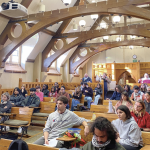BRENDAN CLARK ’21
STAFF WRITER
The Watkinson Library debuted a new exhibit in September that features the library’s impressive collection of rare American periodicals and print-related media spanning two centuries of American history. The collection, which features exhibits on slavery, religion, politics, home life, and literature, among others, offers an impressive insight into the role played by print journalism in the conveyance of popular opinion and the effect that journalism has on government actions. Many of the periodicals offer an “underappreciated resource,” said M.D. Leonard Banco, the guest curator of the exhibit. Banco—who was formerly a doctor with the Connecti-cut Children’s Hospital and is a current Trustee of the Watkinson—began this project three years ago and has been working steadfastly since then to record the Watkinson’s extensive collection.
Banco has read portions of many of the periodicals in the collection to document the annotations and remarks of previous owners, some of which can be seen in the exhibit. He intends to tackle the Watkinson’s extensive English periodicals collection next. “The opportunity for learning is just incredible,” Banco added, citing many of the publications unique to the collection that the Watkinson has been able to exhibit. “I was surprised at how much original literature was published in magazines,” he added. Indeed, the collection boasts a first edition of James Joyce’s “Ulysses,” considered one of the most influential literary works of the early 20th century, as well as a chapter from Herman Mel-ville’s “Moby-Dick.” Both were originally serialized in print.
Some of the periodicals in the collection continue today, such as early editions of Harper’s Weekly and The Atlantic, displaying the legacy of print journalism and its continuing influence in modern popular culture. One of the periodicals in the collection, “Times and Seasons,” which chronicles the early history of the Mormon faith, is noteworthy not only for its recount of the death of the Mormon leader Joseph Smith but also for the publication’s heritage: a bookplate on the inside of the bound publication indicates it belonged to an individual who was at Ford’s Theater on April 14th, 1865, the date that President Abraham Lincoln was assassinated. “You simply cannot viscerally respond to that,” said Banco, who stressed that the historical context of many of these publica-tions is truly staggering.
The collection’s exhibits display the staggering significance of print journalism as a means for communication, political discourse, and the re-dressing of social issues, especially during the late 19th and early 20th century. To accompany the tour, an analysis of the documents has been com-piled in programs which demonstrate the differing focuses of the exhibit and are available for those who desire a closer look at the individual periodicals themselves.
According to Banco, “People built virtual communities around the networks created by these publications.” The collection contains works as varied as socialist newspapers to a first edition of The Federalist, one of the foundational texts of the nation’s early history. “The exhibit really gives you a sense of how we got to where we are now,” added Banco. However, to truly experience and appreciate the gravity of the exhibit, you would be best served by paying it a visit.
Easy Vehicles of Knowledge for an Enlightened and Free People: Amer-ican Periodicals in the Watkinson, 1750-1950, runs through June 15, 2018 and can be viewed Monday through Friday from 8:30 am to 4:30 pm.
Thursday, February 20 2025
The Student Newspaper at Trinity College in Hartford, Connecticut




+ There are no comments
Add yours